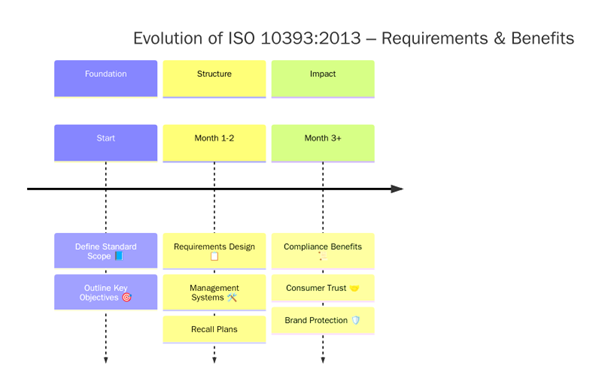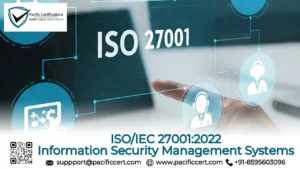What is ISO 10393:2013?
ISO 10393:2013 is an international standard that offers structured guidelines for organizations to plan, implement, and manage effective consumer product recalls. It aims to protect consumers by ensuring unsafe products can be efficiently identified, communicated about & withdrawn from the market.

The standard is applicable to all suppliers in the consumer product supply chain, including manufacturers, brand owners, importers, distributors, and retailers. ISO 10393 is designed to work in conjunction with ISO 10377, which focuses on product safety, making it a vital component of any supplier’s risk and quality management system.
Contact us at support@pacificcert.com for implementation and audit support!
Scope and Applicability
ISO 10393 applies to both voluntary and mandatory recalls of consumer products. It outlines best practices that help suppliers:
- Detect safety-related product issues early
- Communicate clearly with regulators, stakeholders, and consumers
- Plan and execute efficient product retrieval processes
- Conduct post-recall analysis and continuous improvements
The guidelines apply across industries and geographic markets, making them particularly relevant for global suppliers and exporters.
Certification Process
Organizations often choose to implement ISO 10393 principles as part of their internal governance, compliance, and safety programs. The implementation process includes:
- Performing a gap assessment against ISO 10393 requirements
- Designing and documenting a recall management system
- Establishing recall roles, responsibilities, and procedures
- Running recall simulations or drills
- Conducting third-party audits or internal reviews to validate preparedness
Pacific Certifications offers evaluation, training, and support services to help organizations align with ISO 10393, contact us at support@pacificcert.com to know more!
How to Implement ISO 10393:2013 in Your Organization
Implementing ISO 10393 begins with identifying the risks and recall history associated with your product lines. Build a cross-functional recall management team that includes quality, legal, supply chain, and customer service professionals.
Develop a written recall policy that outlines:
- How unsafe products will be identified
- Criteria for initiating a recall
- Steps for stakeholder communication
- Logistics for retrieving and disposing of affected products
- Procedures for root cause analysis and preventive measures
Conduct training and regular recall simulations to validate effectiveness and maintain readiness.
Documentation Required
To comply with ISO 10393:2013, organizations should maintain:
- A documented recall policy and standard operating procedures
- Hazard assessment records and recall decision logs
- Contact databases for regulators, customers, and partners
- Templates for public notices and regulatory communication
- Training records and recall simulation reports
- Records of recovered products and disposal certifications
These documents serve as evidence of compliance and readiness during audits or investigations.
Eligibility Criteria
Any business that supplies consumer products can implement ISO 10393. This includes:
- Product manufacturers and assemblers
- Brand owners and private label suppliers
- Importers and exporters
- Wholesalers and retailers
It is particularly beneficial for businesses in high-risk sectors such as food, toys, electronics, personal care, and household goods.
Certification Costs
The costs depend on:
- The scale and complexity of the organization’s supply chain
- The number and risk category of consumer products offered
- The state of existing recall protocols and preparedness
- The extent of employee training and recall simulations
- The need to integrate with ISO 9001, ISO 10377, or other standards
Costs are determined during an initial consultation or gap assessment, if you are looking for a quote, contact us at support@pacificcert.com.
Certification Timeline
Week | Activities |
Week 1 | Conduct gap analysis and assess recall history |
Week 2 | Establish recall team and define roles and responsibilities |
Week 3 | Draft policies, procedures, and communication templates |
Week 4 | Conduct training sessions and simulation exercises |
Week 5 | Finalize recall documentation and test communication channels |
Week 6 | Evaluate readiness and integrate recall management with other systems |
Timelines may be extended based on business size and complexity, contact us at support@pacificcert.com for a personalized roadmap!
Requirements of ISO 10393:2013
ISO 10393:2013 outlines specific requirements to help suppliers build an effective recall system:

- Recall Planning: Organizations must prepare a documented recall plan, appoint a recall team, and define recall criteria.
- Hazard Detection and Assessment: They must establish procedures to monitor complaints, quality issues, and regulatory notices to detect emerging product risks.
- Stakeholder Communication: Clear, rapid communication strategies are required to inform regulators, partners, and consumers during a recall.
- Recall Execution: Businesses should ensure that affected products can be traced, collected, and disposed of in an effective and lawful manner.
- Post-Recall Analysis: Root cause analysis must be performed after each recall to drive corrective and preventive action.
- Documentation and Recordkeeping: All stages of the recall process should be documented for traceability and audit purposes.
Benefits of ISO 10393:2013
Implementing ISO 10393 offers critical benefits to organizations:

- Safety Assurance: Enables timely removal of hazardous products from the market
- Regulatory Alignment: Supports compliance with global recall laws and industry regulations
- Brand Protection: Reduces reputational damage by demonstrating responsible recall practices
- Operational Readiness: Enhances organizational preparedness through structured plans and simulations
- Cross-functional Collaboration: Encourages coordinated efforts among departments
- Continuous Improvement: Promotes root cause analysis and future risk prevention
- Market Competitiveness: Builds trust with regulators, retailers, and consumers, supporting market access
With growing consumer awareness and digital traceability tools, recall transparency has become a market differentiator. Global regulators are increasingly demanding formalized recall procedures and proof of action within hours of identifying product hazards.
A recent report from the International Consumer Product Safety Association showed a 25% increase in global recall activity, particularly in categories like electronics, children’s toys, and food contact materials. Simultaneously, over 60% of multinational companies now include ISO 10393 principles in their risk management systems.
The standard is gaining traction in regions where cross-border commerce and e-commerce are exposing consumers to diverse safety risks. It complements both proactive standards like ISO 10377 and management system frameworks like ISO 9001 and ISO 31000.
Contact us at support@pacificcert.com to know more!
How Pacific Certifications Can Help
We at Pacific Certifications assist businesses in building structured recall systems in line with ISO 10393:2013. Our services include:
- End-to-end implementation planning and documentation
- Gap assessments and recall readiness reviews
- Team training and recall simulation exercises
- Drafting SOPs, recall notices, and regulator communication templates
- Integration with ISO 10377, ISO 9001, and industry-specific quality standards
We work across various industries including consumer electronics, toys, food and beverages, and personal care. Our goal is to make your organization recall-ready, compliant, and resilient.
Contact our team at support@pacificcert.com to start your ISO 10393 journey!
FAQ: ISO 10393:2013
Is ISO 10393:2013 a certifiable standard?
No, it is a guideline and not intended for certification.
Can we audit our system against ISO 10393?
Yes, internal or third-party audits can be conducted for compliance and readiness.
What is the difference between ISO 10393 and ISO 10377?
ISO 10377 focuses on preventing safety risks in product design; ISO 10393 deals with managing risks after products are in the market.
Does ISO 10393 apply to online businesses?
Yes, E-commerce businesses supplying consumer products should also adopt structured recall procedures.
Is ISO 10393 legally required?
No, but it supports compliance with local recall laws and industry regulations.
Ready to get ISO 10393 certified?
Contact Pacific Certifications to begin your certification journey today!
Suggested Certifications –






